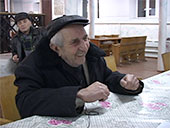
David Soyfer was born in 1930 in Berdychiv. His father, a kosher butcher, was also born in Berdichev and his mother was born in a village near Zhytomyr. He grew up with one brother. During the Famine, he moved to the village to live with his grandmother on a collective farm. In 1939, he returned to Berdichev to live with his father. During the war, he evacuated to the northern Caucasus, and then to Kazakhstan. In 1950, after his return to Berdichev, he was drafted into the Red Army for three and a half years. After his service, he worked as a cooper for thirty-five years. His has one daughter, who lives in Berdychiv.
“make it a synagogue”
Berdychiv, Ukraine
David Soyfer remembers that when returned to Berdychiv from evacuation immediately after the war, the pious prayed outside in the empty courtyard against the synagogue wall.
At times, the needs of the community conflicted with the needs of individuals for shelter and basic necessities. Some sought to rebuild communal life and religious institutions first, whereas others prioritized private housing. Similar debates beset the Soviet reconstruction effort at all levels: most famously, the central government ordered the reconstruction of the tsarist palaces surrounding Leningrad before the population of the city had been provided with adequate housing and hospitals.
On a smaller scale in each and every town that had been destroyed by the war, the local population argued about whether resources would be best allocated toward restoring large symbolic buildings or meeting the more mundane needs of the population.
Source: Jeffrey Veidlinger, In the Shadow of the Shtetl: Small-Town Jewish Life in Soviet Ukraine (Indiana University Press, 2013)
